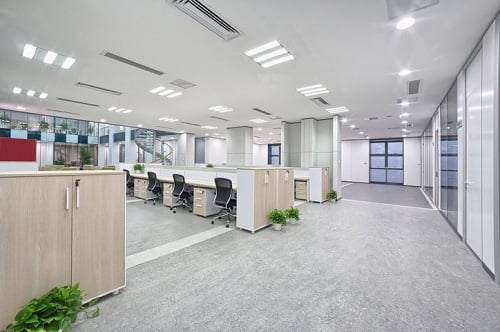In an industry that once desired permanence, more law firms are showing interest in flexible space

The COVID-19 pandemic is pushing tenants cross-industry to re-examine their real estate. As more workforces go remote, many companies are looking for flexibility, and in some cases, less space. Law firms are no different.
Traditionally, law firms required nicely appointed space with large private offices to give the appearance of solidarity, stability, and competence; they tended to prefer long-term leases to amortize improvements to the space. For larger firms, it usually comprised of partner offices, associate offices, conferencing facilities and dining areas.
Fast forward to present day, eight months into the pandemic, and uncertainty of the future remains. The use of space has changed dramatically to accommodate social distancing and incorporate new work-from-home models.
“Partner and associate private offices are configured to allow social distancing already,” said Michael Colacino, president at SquareFoot, a flexible space provider based in New York. “The bigger issue comes in with conferencing facilities, which is becoming irrelevant.”
Subleasing that space will become a trend, he adds, and with several firms devoting entire floors to conference rooms, he expects there will be a reimagining of that space.
With a hybrid of work-from-home and in-office models expected going forward at several firms, this is pushing many to consider flexible space themselves. At SquareFoot, where business is mostly driven by online inquiries, interest in flexible space from law firms went up 10-fold in the past few months. In March and April, law firms made up about 2% of lead volume, compared to September, where they made up over 20%.
“That increase tells me that lawyers are very savvy about lease expirations and more sophisticated when it comes to negotiating leases. In many cases, they are looking to change in order to reduce space and real estate costs,” said Colacino.
Law firms average around 1000 square feet per attorney, added Colacino, but that number has been dwindling. Todd Lippman, vice chairman at CBRE, told Law.com that while trends vary by geographic market, more than two-thirds of firms are moving toward one-size offices, which are shrinking as a result.
“Making a bet on flexibility right now can pay off. We’ve seen law firms looking for shorter-term leases on nicely appointed space, that still allows for an aesthetic office with high quality fixtures and furniture,” said Colacino.
One of the biggest motivators to move into a smaller space is cost savings. Real estate is the second largest expense of law firms behind employees, according to Ryan Hoopes, director at Cushman and Wakefield in Dallas. In Dallas, he says real estate is about 5.4% of a firm’s revenue, and that figure is expected to continue to decrease. With some law firms having a distribution per partner model, rent becomes a high-priority issue.
Colacino says many of them also struggle to come to terms with the premium price tag attached to flexible space compared to that of a long-term leased office space, but the benefit of freedom and minimized liability and commitment that flex space offers might outweigh those concerns in some cases.



